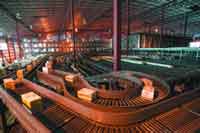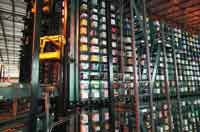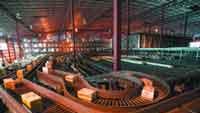Distribution Center is the Toast of Liquor Control Boards
 |
 |
|
Operator places a pre-printed code on each case for tracking purposes and push the cases from the pallet onto the conveying system. |
 |
|
Up to 75 percent of the cases used to fill each order are automatically picked fron 28 horizontal carousels using 14 robots. |
Facing mounting public pressure to either meet rapidly growing order complexity with an outdated order-fulfillment system, or be forced to privatize liquor distribution, the Washington State Liquor Control Board (WSLCB) elected to meet this challenge by transforming its entire operation from an aging, paper-based, manual order-filling facility into a new, highly automated distribution center.
The new 163,200-square-foot facility, located in downtown Seattle, opened in September 2001 and reached full compliance acceptance in October 2002. The $30 million distribution center now operates a unique automated order-fulfillment system which rivals private commercial distribution facilities in both cost savings and efficiencies—handling around 3,000 active stock keeping units (SKUs) and scaling from processing 12,000 cases per day to over 30,000 cases per day at peak season demand.
The Drivers for Automation
The need to automate came from four primary drivers. These included the need to improve order-fulfillment rate, order accuracy, inventory accuracy, and ergonomic/labor conditions.
The WSLCB formerly operated in an outdated building; utilizing pushcarts, hand trucks, and paper pick systems. Some of the pressure to upgrade came from an unprecedented increase in the state’s order complexity due to the growing number of liquor products and the proliferation of package size options within each type of product.
“We wanted to offer a better level of service to our 360 stores, which are made up of state owned stores, contract owned stores (a liquor section within a private store, typically in an unincorporated area), military stores, and tribal stores,” says Gene Kremer, Gener al Manager of WSLCB. “With a once per week delivery schedule, the distribution center had to execute every order within a given window of time while achieving high order fulfillment rates and accuracies.”
Another driver for automation was the need for better inventory management within the facility. The existing inventory management system made it very difficult to maintain accurate inventory information and almost impossible to provide timely information on product movement between the stores, the distribution center, and the liquor suppliers. Safety stocks had to be carried at high levels within the facility and order shortages occurred at an unacceptable frequency.
Ergonomics was another important priority in the decision to automate. In its existing facility, WSLCB employees were picking from pallets on the floor—ergonomically the worst kind of pick. The state faced increasing pressure to comply with OSHA lifting requirements. Employee turnover was high, and productivity was reduced by this continual heavy lifting.
Overcoming Project Challenges
Faced with growing maintenance and order fulfillment problems, the State of Washington initially undertook studies to upgrade and repair the original warehouse, resulting in an estimate of $6 to 8 million for makeshift, short-term repairs. The governor then explored the option of privatizing the facility after a state consultant recommended outsourcing all distribution to a third party. Costs, however, came in at approximately $25 million per year and the proposal was defeated because of the high ongoing costs. The governor then stipulated requirements that the cost of the facility upgrade must be revenue neutral and maintain employment for all union workers who were state employees.
In 1994, the Washington State Office of Financial Management (OFM) began its analysis of upgrade options to fix the old facility that was built in 1948. The OFM proposed to the legislature that a new construction was a more feasible option, with a price tag of $30 million for a building and material handling system. The project was approved, and tear down commenced in 1995. Five years later, with the new building complete, construction commenced on the new state-of-the-art order fulfillment solution.
Site Selection
After looking at 40 possible sites including Puget Sound and Tacoma, the lowest cost option proved to be the current downtown Seattle site, where population density was the greatest and offered the most cost effective transportation system.
The Bidding and Procurement Process
According to Kremer the state is very conscious of the need to analyze the spending of public funds. Many agencies with divided responsibilities, including Labor and Industry, OSHA, Contract Administrators from the Office of Financial Management, as well as governor appointed board members were involved in the analysis.
“After all stakeholders have collaborated in a lengthy re-view process, the project was subjected to a public hearing in which all parties remained involved,” says Kremer.
Labor in the facility, which is unionized, was encouraged by the WSLCB to be part of the design process and input was received from workers via representatives from the Teamsters Union.
The concept of how to build a material handling system was something in which many of the state agencies had little or no prior experience. Education was needed to learn both the technology constraints, as well as the market costs for the proposed design options.
“We had to work very hard to fit into the financial parameters and meet performance criteria,” says Mike Wolf e, WSLCB Project Manager. “As we l ear ned where the challenges in a design arose and which technologies were available to overcome them, the process of bidding became drawn out and took one to two years to finalize.”
Back to the drawing board—An innovative design solution
After failing to secure a material handling solutions contract which could meet the initial restrictive bidding and design parameters, WSLCB partnered with Pinnacle Consulting material handling specialists to get the bid out. Pinnacle worked with the WSLCB to develop a performance-based bid document that allowed potential material handling system suppliers to recommend the best solution to meet the WSLCB operational requirements within its budget constraints.
“For a material handling system we wanted something as ergonomic as possible—some-thing that was modern and could carry into the future,” says Kremer.
“The design challenge was to create a system that would achieve the desired order-fill rate and order accuracy, while providing the flexibility for future product/packaging changes and volume growth potential, and remain within our budget,” says Kremer. “It’s a very complex system.
“This is one of the few projects that Washington State has tackled that has been achieved with available funding and it’s a lot different than we originally conceived.” says Kremer.
The Seattle distribution center was designed, built, installed, and integrated by order fulfillment specialists FKI Logistex Alvey Systems. Alvey Systems won the bid with an innovative, low-cost solution. “Alvey’s experience with order fulfillment systems , divers e material handling product and solution capabilities, and record of successful integration of information flow allowed us to develop the right solution to meet all of the WSLCB requirements,” says Ken Thouvenot, V.P. Project Management and Marketing for Alvey.
The result? Increased productivity, order accuracy, and profitability
The new material handling solution offers an increase in productivity utilizing the existing labor force, increased order-fulfillment capacity by 15 percent to 17,000 cases per eight hour shift, a reduction in product breakage/loss, and a quantum leap in order fulfillment accuracy.
Creating a baseline and improving the audit trail
Prior to the new system being installed in Seattle, there was no accurate way of measuring overall material flow. “Our order accuracy has increased dramatically from 90 percent in our previous facility to as high as 99.7 percent. We are able to move up to 30,000 units per day. With our new automated handling system, the client stores as well as the vendors have been pleased with the accuracy and shortened turn-around times,” reports Kremer.
In the past, the center had to calculate order fulfillment statistics from sales data. The new system forces stores to pay attention to order accuracy and be more responsible in ordering. “They no l onger have to compensate with over orders, and it adds up to better control of assets and improved forecasting for the procurement department,” says Kremer.
Because alcohol is a controlled substance, the state auditor is sensitive to lost, stolen, mis-shipped, and broken product. Security is greater in the new facility with video cameras trained on all parts of the interior and exterior. Overall product loss is decreased further by more gentle material handling suited to fragile shipments.
The distribution center is now reporting 80 percent reduction in breakages and a subsequent increase in (undisclosed) net profit—50 percent of which is distributed to Washington State’s general fund and 50 percent to county funds for community use.
A better trained and more stable work force
In a manual material handling system, faulty processes are easily masked. The Seattle facility is designed and implemented to guide operators into a new discipline, offering accurate benchmarks and an inventory audit trail. While the effect of better performance tracking and order accuracy puts pressure on workers as well as stores to meet more exact performance standards, workers were able to be quickly retrained in the operation of automated systems, including the use of new computer terminals. WSLCB now has a better-trained work force that is more stable. Overall labor productivity has increased as the distribution center is now designed to scale to handle peak demand without the typical seasonal increase in the work force.
Real-Time Inventory Management—a Plus for Vendors and Stores
Improved inventory and increased order accuracy, combined with shorter turn times is a plus for wine and spirit vendors who are required to ship all orders on consignment to the warehouse in a process called a bailment system. It is not until the goods, held on consignment, are recorded as shipped from the distribution center that it is a cost to the state. Improved tracking and more accurate reordering have resulted in faster and more accurate payments to vendors.
The material handling system offers faster and more accurate order fulfillment so that store movement is now more closely aligned with inventory supply. The real-time inventory management system allows more frequent and smaller shipments from vendors and a reduction of inventory at the store level resulting in keeping pace with increased sales demand and decreasing in-store inventory hold times and storage costs.
Today, the Seattle operation of the WSLCB is the most automated liquor control board distribution facility in the United States and is gaining a reputation as the automation model for liquor boards across North America.
|
PRO PATHWAYS FKI Logistex Alvey Systems— order fulfillment specialists. Visit: www.fki;pgostex.com Pinnacle Consulting—material handling specialists. Visit: www.pinnacle grp.com Washington State Liquor Control Board—Visit: www.liq.wa.gov |


















